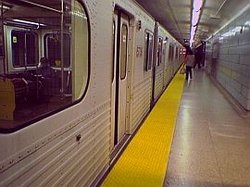Yonge-University-Spadina (TTC)
|
|
| Toronto Subway/RT | |
|---|---|
|
|
Yonge-University-Spadina |
|
|
Bloor-Danforth |
|
|
Scarborough RT |
|
|
Sheppard |
The Yonge-University-Spadina Line is the oldest subway line in Toronto, Ontario, Canada, operated by the Toronto Transit Commission. It has 32 stations and is 30.2 km in length. It opened in 1954, and had extensions completed in 1963, 1973, 1974, 1978, and 1996. One station (North York Centre) opened on an existing section of line in 1987.
The line's name has changed as it was extended. It was simply the Yonge subway until 1963, then the Yonge-University Line until 1978. Although only two stations are actually on Spadina Road, a larger portion of the line was originally planned to follow the Spadina Expressway. The part of the expressway that was actually built was renamed the W.R. Allen Road, but the name of the line was never adjusted. It is also numbered as Route 1 (formerly route 601), but its route number is predominantly used by the TTC for internal purposes and is rarely used by the public or on TTC maps.
History
On 30 March 1954, after five years of work, the first subway in Canada opened to the public. The original Yonge Street subway line went from Union Station north to Eglinton station. Premier of Ontario Leslie Frost and Mayor of Toronto Allan Lamport, among other important persons, rode the first train that morning, going north from the yards at Davisville station, and then from Eglinton, south along the entire line. That day, at 2:30 PM, the last streetcar to travel Yonge Street south of Eglinton made its final trip.
Nine years later, the University segment of the line opened, continuing the line from Union north to St. George station.
In 1973, the Yonge line was extended north to York Mills station, and the next year it was extended north to Finch station. in 1978, the Spadina segment of the line was opened, going from the north terminus of the University line to Wilson station.
In 1987, a new station was added south of Finch on the Yonge line, at the North York Centre. In 1996, the Spadina expansion was opened, adding one new station, Downsview station.
This line is expected to see the next phase of expansion, which will bring the line to York University, four kilometres northwest of Downsview station. There are proposals to extend the line further, into the city of Vaughan. Preliminary route planning has begun, although at present, the TTC has funds only for an environmental assessment. The extension got a further boost in 2004 when the Toronto Argonauts Canadian Football League team announced their intention to move to a new stadium at the York campus, but this plan was cancelled six months later. In the meantime, a temporary busway is planned between Downsview station and the campus. See the link below.
Proposals have also been put forward to extend the Yonge Street portion of the line beyond Finch to Steeles and into Thornhill, most likely ending at a terminal station at Highway 7. This extension is not expected to be built in the near future.
Stations
The line forms a rough U-shape. Its western leg starts at the northern terminus of Downsview station, at Sheppard Avenue and W.R. Allen Road ("Allen Road"). The line follows the Allen Road, which becomes a small expressway, travelling in its median for 6 km. Continuing southeast below the Cedarvale and Nordheimer Ravines, it turns south under a short stretch of Spadina Road. After sharing the Bloor-Danforth's Spadina and St. George stations, the line turns south again under Queen's Park, passing to one side of the legislature, and running the full length of University Avenue beyond. It turns east on Front Street to serve Union Station, Toronto's main rail hub, and then north.
The eastern leg runs straight up Yonge Street for 16 km, crossing the Bloor-Danforth line again at Bloor-Yonge, and the Sheppard line at Sheppard-Yonge, before reaching its northern terminus at Finch station.
The line is generally underground, but has several surface or elevated sections between Downsview and Eglinton West, and between Bloor and Eglinton. Most of the tunnel was constructed by cut-and-cover, but some was bored, as noted below. All stations, whether by transfer or fare-paid terminal, connect to surface TTC bus and/or streetcar routes. Other surface and train connections are noted below.
As of 1 October 2004, stations marked Missing image
Wheelchair.jpg
have elevators for wheelchair access. By the end of 2005, an accessible elevator will be added at Eglinton West station.
External links
- Spadina line extension (http://www.city.toronto.on.ca/ttc/spadina_extension/)
- Transit Toronto (http://www.transit.toronto.on.ca/) (Not affiliated with the Toronto Transit Commission)fr:Yonge-University-Spadina (TTC)

